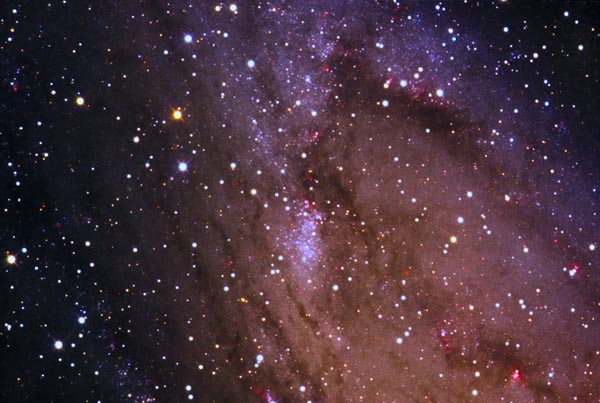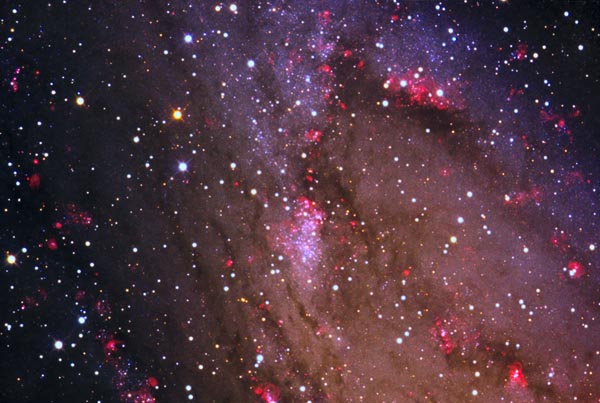|
NGC206
Region in M31
Enhanced
Hydrogen Comparison
Star
Clouds and Emission Nebula in Andromeda
Uploaded
12/12/06

 |
 |
This
4 hour image is a deep LRGB that is G2V calibrated
Select an image size for a larger view:
1024 x 768
1600 x 1200
|
Same
image with an additional 3 hours of hydrogen data added (7 hours)
Select an image size for a larger view:
1024 x 768
1600 x 1200
|
|
This pair of images
should once again satisfy both imaging camps, the purists will
prefer the left shot, a well exposed standard LRGB image with
G2V calibrated colors. The right image will satiate those with
a sound curiosity as to the dynamic relationships between hot
O/B associations and their surrounding hydrogen. I have previously
posted a description of the left image here.
Comparing the two
images.
Most evident from
the larger versions of the right image is the direct relationship
between hot blue stellar associations and red nebulosity. In
many cases, the nebulosity forms partial or complete shells of
material around the stars, such as the stunning round bubble
at the very bottom of the image. Surprisingly, NGC206 which is
the very bright stellar grouping in the center of the image -
a mere spur in the blue arms of the galaxy, is permeated with
large amounts of hydrogen gas. Near the top of the image, another
very large hydrogen region appears associated with the blue arm
stars above it. And the tattered remains of many other small
patches of gas are very apparent, making it a wonderland for
nebulous exploration!
Processing notes:
Combining deep
hydrogen exposures with a normal image is not a simple straightforward
task. The primary difficulty is to remove the red continuum from
the Ha data and all of the stars, so it can be combined by "Screen"
in Photoshop and retain the most faint tendrils of nebulosity
as possible. First, stars were removed by subtracting the blue
data, and a synthetic flat field was created from this image.
This flatfield with no stars was combined with "Screen"
with both the red channel at 100%, and blue channel at 15% for
the final RGB set.
|
Instrument: 12.5" f/5 Home made Newtonian
Platform: Astrophysics 1200 QMD
CCD Camera: SBIG 10XME NABG with Enhanced Water Cooling
Guider: SBIG ST4
Exposure: LRGB = 120:40:40:40 (RGB NOT Binned)
For Enhanced image add 3 hours of Ha Data
RGB Combine Ratio: 1: 1.05: 1.11 = G2V
Filters: AstroDon RGB Tricolor
Location: Payson, Arizona
Elevation: 5150 ft.
Sky: Seeing FWHM = 5 arcsec (Maxim DL - 10min subframe), Transparency 9/10
Outside Temperature: 35 F
CCD Temperature: -30 C
Processing Tools: Maxim DL, Gralaks Sigma, Photoshop, PixInsight, Starizona Debloomer.
HOME GALAXIES EMISSION NEBS REFLECTION NEBS COMETS
GLOBULARS OPEN CLUST PLANETARIES LINKS
|
|